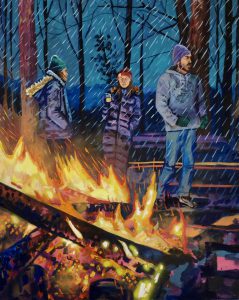
Bonfire Party in the Snow by Danielle Klebes
A Waterbed Fire
Elizabeth Wasdworth
One night my body weight pressed the waterbed heater against my existing futon and started to burn while I slept. The heat on my hip woke me up. I called the fire department. Firefighters work in teams. “You’re lucky it’s us that showed up,” this team told me. “Another crew would’ve caused a lot of damage. Another company would’ve torn this apart with their axe.” This crew doused the futon and threw out the second floor window.
When I see firemen in the grocery store I’m tempted to paint them heroes; surprised to find out the pay out of pocket $$ per day on duty for that food. I want to talk to them but, “So how do you feel about 9-1-1,” seems both stupid and quaint. I tried small talk when they were guests at a community event, but small talk drains. The strain to be polite detracts, drains and exhausts from their time and energy and serious bigger issues.
I read a Firefighters book to understand how firefighters act/react, adjust, adapt, perform, behave; the posture needed and heeded; the upper hand control; I stopped by a fire station recently when I saw the firefighters outside lounging on chairs, but get this: firemen smoking cigars. “You didn’t get the memo?” I asked one. “I did,” he said.
Fire/ambulance/police are not fast food- joint workers in entry level jobs that don’t require training. The danger in not constantly drilling lurks in becoming complacent, lazy, lethargic, lulled by the quiet, tempted even to be lackadaisical waiting for the next call.
“You spend a third of your life with these guys,” a fireman told me. They eat, sleep & work together; blend to maintain survival: theirs and the people they rescue. Firemen learn to trust comrades by observing their behavior, their character, and their abilities. Neither of you will intentionally do something to get each other hurt or killed. Your partner will back you, and look out for you.* You gauge each other and like the military, you need to know: will this soldier work or not, e.g. a fireman can’t be afraid of heights.
Runs are studied for mistakes and/or possible remedy. Emergency personnel study each other. They tease each other to push the boundaries, test the limits, the threshold, and the tolerance of their teammates. Teasing can be insults, but teasing can also relieve tension. I’ve seen this behavior in other venues to annoy, to poke, and pester even, in order to find the weakest vulnerable spot of a new guy to see what attack is most likely to succeed. The intent, cause, purpose, and reason For Personnel to push, probe and provoke and razz is to get a reaction. They ruffle hair out of affection or for getting attention. The worst punishment for any of us in any vocation is to be ignored. To vex, coax, mock, arouse is strictly need to know.
Firemen are not just the life/death/danger they do, but who they are, how they act, e.g., a good guy who helps, or the lazy guy who shirks work. When a veteran guides the new guy with kindness to the pecking order and privileges of seniority he earns the newbie’s respect. After all, I’m crying later as I read ** that the fireman who died was the kind hero the crushed on duty by falling timber in a fire. In the pecking order the new guy learns old rules. Seniority carries both order and earned entitlement. And then there’s the privilege, a man told me, that his firefighter son, “gets to drive the rig” and that his son invited dad to sit down to eat with the crew.
When I was a kid and there was a kitchen fire they couldn’t find me asleep up in my room. When I was an adult and my babysitter called to say there was a kitchen fire a cop stopped my car speeding home. He let me go when I told him why. When my kids were little our local Fire Department would shoot the fireworks display, in a safe way, to celebrate the 4th of July. Last summer an industrial fire poured black smoke over a nearby residential neighborhood. The residents poured out like water from a pitcher onto the sidewalk and walked down to the site to view the spectacle. The flames rivaled both the television and the internet in viewers.
The Emergency Room
Firefighters are either EMTs or Paramedics. The firefighters’ work reminded me of my time in the ER. Of course there’s the trauma of heart attacks, but some calls are bizarre like the inane call to the Fire Department from a woman that her hair brush was caught in her hair. “People call us for plumbing and, electrical, or to plug in their TV,” a fireman told me. A man phoned in to the ER and said, (I quote) “My asshole just fell out,” and I pictured a donut roll down the street. Another man was unable to free his penis from the vacuum cleaner hose. The ER physician’s diagnosis read fractured when I thought only bones fractured. We had a “Holding Room” where people in police custody were held in 4 point restraints. For safety reasons there was a camera in that room. I dubbed it film de jour. Annually coroners circulated a magazine to ERs nationwide of unidentified bodies asking “Have you seen this person?” We had a Quotes Board entitled: people say the craziest things when their blood alcohol level is over legal limits.
People call into the ER constantly to find out whether a trip to the ER is necessary. There’s a dictum that chronic users of the ER– like both the Medical and Law fields I worked in—are ten percent of your clients who took up 90% of your time. One of our staff learned not to rest the phone against your bones when you’ve just said something derogatory like, “I’ve got another crazy on the line.” Bones transmit. Put the phone on hold.
I answered a local public affairs Make-a-Wish campaign and got a Ride-Along with paramedics. When my local community got an ambulance from a federal grant they staffed it with volunteer citizens and I got EMT training. The first run I had as driver my leg shook so badly on the accelerator I could hardly drive.
Paramedic and fire personnel assigned to our ER had to be careful on duty to wear uniforms distinct from police as a caution in dangerous milieus. One of our paramedics carried a pair of boots into the ER the severed legs still in them. Seeing all this –children suffocated in grain, intoxicated college kids falling from a silo elevator–I would often call home from work to see if my kids were o.k. “We’ll sure be glad when you don’t work in ER or Juvie anymore,” they said.
When I hear a siren now I think, “Someone called for help and someone is responding.” I was thinking it would be nice if marriages had partner-with-partner protocol to alert or sensors to detect danger the way firemen do. Firefighters work in teams, like marriage, together in unison, always in sight or at least in arms’ length at the scene of a fire so that they can help each other. When they’re in trouble their beepers shriek to alert them that their partner is in danger or that their partner is down. To be extinguished fire, like passion, is either cooled, or smothered or starved.
A Fireman, a policeman and a pilot have totally different dream contents than you or I.
*&*&*&
Sources:
Dynamics: Vocabulary jargon, vernacular, & unique terms specific to
10-15 min to ignite, to smell smoke
Air tank; Asphyxiate
Arson: opportunity, motive, incendiary origin;
C&O (cause and origin) Q: what/how
Char-pattern,
Color of flame: yellow, org, bright brick cherry or blood red), Color of smoke
Fast, hot vs. slow burn: oil based plastic burn vs. wool/cotton/wood
Grease on glass
Hose
Hydrocarbon fuel
Instant ignite: alcohol (vodka) Near /far: Rate of speed
Ladder
Metal melts at 2,000 F.
Pike and Poles
Seats backward
Spalling, shards, small pattern crazing; sooty residue
Truck vs. engine
Elizabeth Wadsworth Ellis’ friend is the dictionary; the library, her watchtower.
Danielle Klebes is a multidisciplinary artist from North Adams, MA. She has exhibited at notable galleries and museums across the United States and in Canada. She has been spending much of 2019-2021 participating in domestic and international artist residencies, and is currently the Programming Fellow at Wassaic Project in Wassaic, NY. Danielle received her MFA in Visual Arts from Lesley University College of Art and Design in Cambridge, MA, in 2017.
